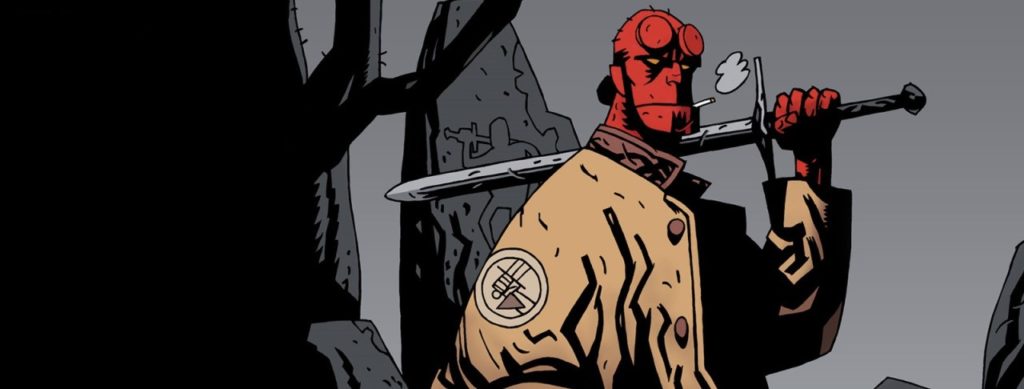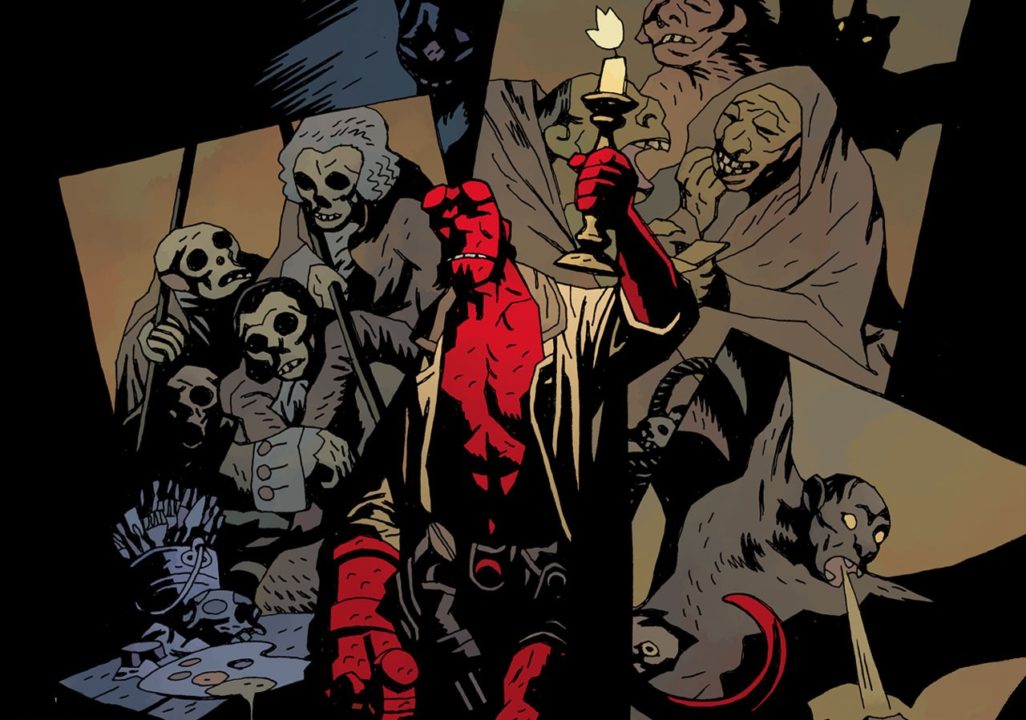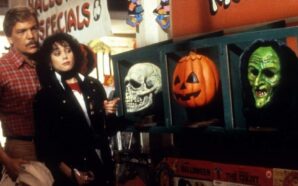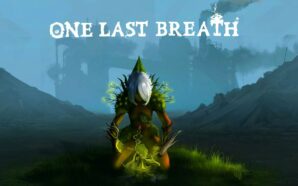Originally posted by Stuart Kirkman
The final issue of Mike Mignola’s Hellboy in Hell hit stores this week, and it marks the end of a story that began way back in 1994 with Seed of Destruction. Since then there have been fourteen volumes of the main series, multiple spin-off titles, and two blockbuster movies. The wider Mignolaverse will no doubt live on for a while longer, as there are plenty of stories left to tell, but the journey Hellboy embarked upon 22 years ago has come to an end.
Hellboy’s story is a rich tapestry of tales that come in various sizes; the smaller ones range from a few pages to a couple of issues, and can take place anywhere in the timeline. Whereas the larger stories are 5-6 issue mini series that drive the main plot forward. Reading through everything the first time puts the reader in Hellboy’s hooves, as the pieces of a puzzle are slowly revealed to him, but not how they fit together. Reading everything for a second time offers a new appreciation of the gigantic tapestry that Mignola has carefully woven together, and how the title character is one of the most interesting creations in modern comics.
Hellboy > Doc Savage
Pulp heroes are a dying breed. Nowadays audiences demand nuanced characters; good guys with a dark side and bad guys who are sympathetic. Everything is gritty and realistic, and the line between good and evil is blurry at best. Back in the old magazines you just needed a square jaw and a Nazi to punch. Heroes of the 30’s and 40’s would just charge around the streets thumping monsters and mobsters in the face, rescuing the girl and saving the day.
Hellboy takes us back to that time in a lot of great ways; It’s a story of good vs evil, sure the good guy might look like the devil, but the bad guys include a Nazi scientist who has been reduced to a swastika-tattooed head in a jar, and spends his free time creating cybernetically-enhanced fighting apes. That’s not to say that there aren’t nuances in the storytelling; there are characters whose allegiances aren’t entirely clear, and Hellboy himself is anything but a straight up pulp hero, but when the villains want to bring about the apocalypse, it’s easy to see why that’s a bad thing.
Hellboy > King Arthur
The mythology in Hellboy is dense and sprawling. The story takes place over a period of decades, and as we hop around the timeline, Hellboy travels around the world to do battle with all manner of magical and supernatural creatures. Mike Mignola loves folklore, so rather than creating Hellboy’s adversaries from scratch he draws on the mythologies from various countries and integrates them into his story in a seamless way. Some of them we’re familiar with, but others are more obscure and lesser known.

This has combined into a multicultural patchwork quilt of mythology that Hellboy can run around in and never feel out of place. In fact, as the story develops we slowly learn that Hellboy is a very important figure in this world. He’s not just a demon from hell; he also has interesting links to witches in England and even Arthurian legend. He’s known to magical creatures of all varieties, and several spirits take a keen interest in his journey. He’s very much at the centre of this world, even though that’s the last thing he wants.
Hellboy > Superman
The story is Superman is one of the most well-loved in all of pop culture; it’s about a guy with almost limitless power who is sent to Earth as a child and raised by normal people. He’s destined to save/lead/conquer the human race (depending on the writer), but in his heart he just wants to be a normal human.
The thing about Clark Kent is that he can pass for human, so when he’s finished whining about how he’ll never fit in he can put on his glasses and go about his day. Mignola takes this core concept to the extreme, and makes the idea more interesting in the process. Hellboy is the ultimate nature vs nurture story; he’s a demon sent to Earth to bring about the apocalypse, this is his destiny and it might just be unavoidable. But just like Clark Kent, his adopted father has taught him about humanity, and that’s what made him who he really is.
Outwardly, Hellboy is the opposite of a normal hero. A big red monster with a tail and cloven hooves. He’d even have a pair of monstrous horns is he let them grow to full size. Regardless of his appearance, no one in his world is afraid of Hellboy, and as he travels around the four corners of the world he’s never treated like an animal or a monster. In a world obsessed with bigotry, it’s refreshing to exist in one where people are treated based on how they act, not how they look.
Hellboy > Ben Hur
Epic is a word that has been misused so often that the meaning has been lost. Stories of epic proportions are becoming rarer and rarer as we consume our media in smaller and smaller formats. Hellboy is truly epic in the old sense of the word. The main story so far can be broken into three big acts:
- Hellboy becomes aware of his role as the Beast of the Apocalypse
- Hellboy runs away from his destiny and buries his head in the sand
- Hellboy stares his fate in the eye and takes action to change it
This all takes place over twelve volumes, but there are short stories, graphic novels, prequel volumes and spin-off series that all add to this grand tale. Mignola oversees it all, and almost everything counts towards the whole. You don’t need to read everything to understand what’s going on, but if you invest the time in the extended universe you will be rewarded with easter eggs, character appearances and a greater understanding of how everything fits together.
As a story and a character, Hellboy is a contradiction in many ways. The premise is simple on the surface, but the lore is very deep. He’s a tragic figure who is trying to make the world a better place, but all of his good work contributes towards his eventual undoing. This combination of classic and modern ideas creates something which feels wholly original.
If you’ve never read any Hellboy before then you should rectify that as soon as possible. the main series can be found in 12 Trade Paperbacks or 6 gigantic and beautiful Library Editions
. Hellboy in Hell will be collected in two trades, and we’ll hopefully be given a final Library Edition in the coming months. So add the first one to your basket and head to the checkout, because once you’ve stepped into that world you’ll realise how much you’ve been missing out on.








